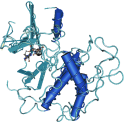
- Remove this product from my favorite's list.
- Add this product to my list of favorites.
Products
Newsletter
 |  |  |  |  |  |

Cdks are the catalytic subunits of serine/threonine protein kinases which are involved in the progression through the cell cycle. The catalytic activity of these kinases requires interaction with cyclins, which are synthesized and degraded during the cell cycle in a cyclical fashion. Induced by mitogenic signals cyclins of the D-type family (D1, D2, and D3) are synthesized, bind and activate CDK4 and CDK6. Active complexes are involved in entering the G1-phase and regulate the early phase of G1 by phosphorylation of the retinoblastoma protein (Rb), p107 and p130. While CDK6 has long been understood only as a mitogenic factor, some studies have indicated that CDK6 can inhibit cell proliferation, suggesting a transcriptional mechanism of CDK6 function in the process of differentiation.
Recombinant human cyclin-dependent protein kinase CDK6, coexpressed in complex with Cyclin D1.
Theoretical MW (CDK6/CycD1): 63.3/60.0 kDa (fusion proteins)
Expression system: Baculovirus infected Sf9 cells
Purification: One-step affinity purification using glutathione agarose
Storage buffer: 50 mM Hepes, pH 7.5; 100 mM NaCl, 5 mM DTT, 15 mM reduced glutathione, 20% glycerol
Protein concentration: 0.388 mg/ml (Bradford method using BSA as standard protein)
Method for determination of Km value & specific activity: Filter binding assay MAFC membrane
Specific activity: 104 000 pmol/mg × min
Entrez Gene ID: 1021/595
UniProtKB: Q00534/ P24385
Ordering information: shipped on dry ice
Grossel MJ, Hinds PW. (2006) "Beyond the cell cycle: a new role for Cdk6 in differentiation." J Cell Biochem. 97(3):485-93..
Sanchez I, Dynlacht BD. (2005) "New insights into cyclins, CDKs, and cell cycle control."
Semin Cell Dev Biol.,16(3):311-21.
Malumbres M, Barbacid M. (2005) "Mammalian cyclin-dependent kinases", Trends Biochem Sci.,30(11):630-41.
Meyerson M, Harlow E (1994) "Identification of G1 kinase activity for cdk6, a novel cyclin D partner." Mol Cell Biol. 14(3):2077-86
Guan KL, Jenkins CW, Li Y, Nichols MA, Wu X, O\'Keefe CL, Matera AG, Xiong Y (1994) "Growth suppression by p18, a p16INK4/MTS1- and p14INK4B/MTS2-related CDK6 inhibitor, correlates with wild-type pRb function." Genes Dev. 8(24):2939-52
Russo AA, Tong L, Lee JO, Jeffrey PD, Pavletich NP (1998) "Structural basis for inhibition of the cyclin-dependent kinase Cdk6 by the tumour suppressor p16INK4a." Nature 395(6699):237-43
Brotherton DH, Dhanaraj V, Laue ED et al. (1998) "Crystal structure of the complex of the cyclin D-dependent kinase Cdk6 bound to the cell-cycle inhibitor p19INK4d." Nature 395(6699):244-50
Mahony D, Parry DA, Lees E (1998) "Active cdk6 complexes are predominantly nuclear and represent only a minority of the cdk6 in T cells." Oncogene 16(5):603-11
Arbogast A, Boutet S, Phelouzat MA, Plastre O, Quadri R, Proust JJ (1999) "Failure of T lymphocytes from elderly humans to enter the cell cycle is associated with low Cdk6 activity and impaired phosphorylation of Rb protein." Cell Immunol. 197(1):46-54
Ojala PM, Yamamoto K, Castanos-Velez E, Biberfeld P, Korsmeyer SJ, Makela TP (2000) "The apoptotic v-cyclin-CDK6 complex phosphorylates and inactivates Bcl-2." Nat Cell Biol. 2(11):819-25
Schulze-Gahmen U, Kim SH (2002) "Structural basis for CDK6 activation by a virus-encoded cyclin." Nat Struct Biol. 9(3):177-81
Welcome Login
Contact us
Follow us